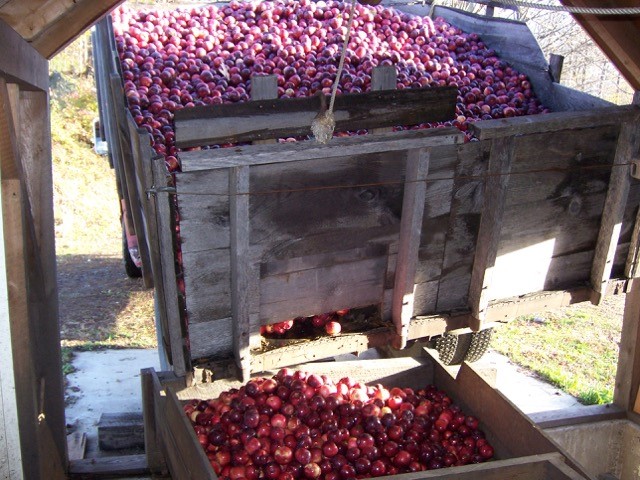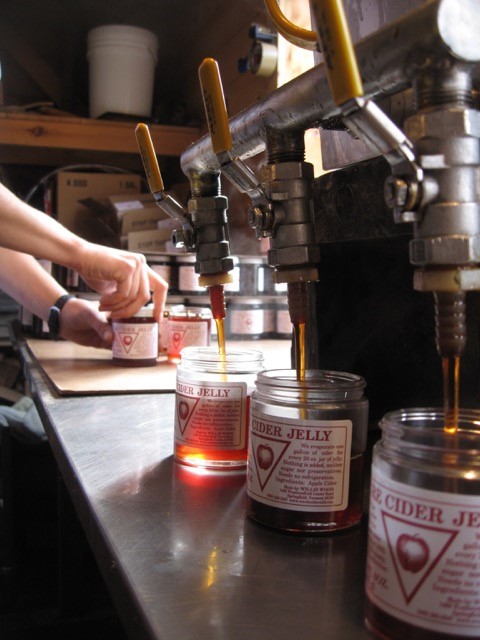Since 1882, Willis Wood’s family has run Wood’s Cider Mill in Weathersfield, Vermont, on land first settled by Willis' ancestors in 1798. Willis and his wife, Tina, took ownership from a relative of Willis’s in the 70s—when Willis and Tina were in their 20s and he was in his 80s. Having raised their family (and now raising their grandchildren) on the farm, they’ve dedicated their lives to preserving the almost-once-lost arts of making boiled cider, cider jelly, and cinnamon cider syrup.
Nearly all the apples they press are Macintosh varietals that come from farms within a 30 mile radius of their mill—a total of 12,000 bushels annually.
Willis Wood shares in a warm voice that rings of a smile, “We press apples straight out of the orchard, so when they come, we start. Generally, we start pressing mid-September and when it gets cold we stop—around Thanksgiving, or sometimes into December. The mill roof cupola stays open to let the steam out when we are boiling,” Willis laughs, “which makes this a great fall job, but a miserable summer or winter job when you are steaming or freezing.”
The Woods’ hard labor and love of their work adds up to bold apple taste and a built-in sense of reverence for their craft.
Boiled Cider
For those not familiar with this product, Willis explains, “Boiled cider isn’t just pasteurized cider. Sweet cider, evaporated about 7 to 1, makes boiled cider. Evaporating it a bit more—about 9 to 1—makes cider jelly. Both boiled cider and cider jelly are traditional New England products. New England cooks traditionally used boiled cider for making pies—a custard-type pie, mincemeat pie, or for making boiled cider apple sauce—a rich chunky sauce. Any time that you cook with apples, if you add a bit of boiled cider you can really increase the apple flavor. We use it in our home cooking all the time—in salad dressing, as a glaze for pork or chicken. It’s even great with Chinese food as a sweet and sour.”
“I’ve read accounts of boiled cider, called apple molasses, produced in Northeast in the 1600s. My family used to ship 30-gallon barrels of it to the South as an ingredient for soft drinks.” At The Savory Pantry, we also love incorporating it into fall cocktail recipes.
To create Wood's Cider Mill's Cinnamon Maple Syrup, boiled cider is combined with pure Vermont Maple Syrup and a touch of cinnamon to create a zesty syrup that adds interest to pancakes, waffles, and french toast.
Cider Jelly
Willis shares, “When people come to the mill and taste cider jelly, they are surprised by the intensity. Those used to apple jelly can’t believe the concentration of flavor to sugar in cider jelly. Usually when you think of jelly, you imagine something sweet, with flavor playing a secondary role. With cider jelly, the tartness and the flavor proceed the sugar. So that changes cider jelly from a morning spread to something that works perfectly with cheese, or even ice cream.”
“Cider jelly is an old-time pantry staple, created as apples’ pectin causes a natural jelling process when boiled. Over a century ago, many cider mills made cider jelly—a common food throughout the 1800s. With commercialization and mass availability of jams and jellies, small-scale cider jelly making took a back seat to mass production. With today's strong, revitalized interest in local foods and appreciation for the slow food movement, products like cider jelly are experiencing renewed interest. In our home kitchen, we use the jelly on toast, and to spread on sandwiches. It’s also great with turkey or chicken as you would use cranberry sauce.”
Cider jelly remains the biggest seller for Wood's Cider Mill, and the Woods make between ten and thirty thousand pounds of this glorious jelly each year. Below, Willis Wood's daughter, Marina, jars the jelly.
A Storied History
First run as a sawmill, the mill was adapted to cider production when there was so much demand for boiled cider that it made sense to switch from lumber. “My family started making cider, cider jelly, and boiled cider when they converted their old, water-powered, up-down sawmill to a cider mill in 1882. In that era, plenty of local people wanted to bring in apples from their own trees and for custom pressing. My family would charge per gallon or press, often keeping a share of results for their own kitchen. This was not an unusual practice for the time for families to get what they needed, and to make a particular crop last throughout the year.”
“But the boiled cider and cider jelly market dwindled quickly in the 20th century. I think that by the 1950s or 60s, my grandfather’s cousin, Augustus Aldrich, was one of if not the last commercial producer. My guess is that small food artisans lost out as people went to more prepared foods, less home cooking, and more Wonder Bread and commercial grape jelly, like Welch’s. As a consequence, the industry collapsed and vanished. In 1970, it was down to elderly women who were home cooks and would buy when their husbands shot deer so they could make mincemeat.”
“Fortunately, it has blossomed in the last 30-40 years, with significant growth in appreciation for the flavors and moral value of local foods, and encouragement from the slow food movement.”
A Multi-Generational Family Affair
For each season’s production, Wood’s Cider Mill generally burns 60 cords of wood, roughly a 480-foot-long wall of wood. This wood is generally purchased. But, “Recently, we’ve been clearing some pasture land for my daughter’s cows so we have been cutting on our own.”
His daughter, Marina, her husband, and three children between the ages of 7 and 13 live on their own nearby farm. Marina also works in the mill in which she and her brother were raised. (The Wood’s son now lives in Guatemala where he runs an ecotourism business, but Marina has stayed close to home to raise her own family and join at the mill.)
Willis reflected on family farm life, “My wife Tina and I grew up in the suburbs and wanted to live on the farm. We were committed to giving it a try, and it worked out well for both of us. It was a treat for a couple to work together and raise kids without finding daycare.” Laughing boldly, he continued, “You know those kid carriers? I have fond memories of carrying the kids out in backpacks and hooking them to the barn wall while we worked!”
“Today, it takes three people to comfortably work mill. I, my daughter Marina, her cousin named Marina, and a friend Oliver work there, so if we plan things well and nothing breaks (which with a 130-year-old mill is a constant threat), the mill can go 7 days a week and each person only has to work 5 days a week. After we’re done with cider, it’s lambing in January, sugaring for maple syrup in March and April, then it’s time to let the animals out to pasture and rebuild fencing . . . then the process starts all over again when the apples are ready. There’s always work to do on a farm, but it’s a good life.”
Planning your fall foliage tour of Vermont? If you’re near Weathersfield, Willis invites you to come by. “Tour is a fancy word for it, but we invite people to stop in season when we’re working and show them around. Some days there’s no one, other times there are 20 or 30 people.”
Whether in Vermont or nowhere near it, you’ll taste family history and intense New England apple flavor in every product from Wood’s Cider Mill.












